Explore Pattaya - Thailand Travel, Asia
Pattaya, a coastal gem in Thailand, is a city that pulses with energy and allure. Once a quiet fishing village, it has blossomed into one of Thailand's most popular tourist destinations. Known for its stunning beaches, vibrant nightlife, and a mix of traditional and modern attractions, Pattaya offers something for every traveler. Whether you're seeking relaxation, adventure, or cultural exploration, Pattaya has it all. Let’s travel and discover the best that Pattaya has to offer, from its rich history and cultural influence to its top attractions and local delights.
Population: Approximately 120,000 in 2019.
Economy: Pattaya’s economy thrives on tourism, with key sectors including hospitality, entertainment, and retail. Its vibrant beach resort atmosphere and diverse attractions drive significant economic activity.
Landmarks: Famous for the Pattaya Beach, Jomtien Beach, and Wat Phra Khao Yai.
Thailand
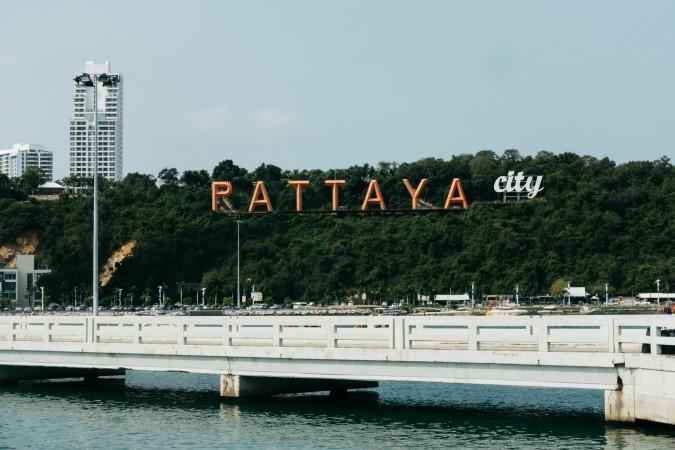
Overview of Pattaya
History & Cultural Influence
Pattaya's transformation from a small fishing town to a thriving tourist destination is nothing short of amazing. Today, Pattaya is a melting pot of cultures, where traditional Thai values blend seamlessly with international influences. The city’s cultural landscape is rich and diverse. You’ll find the grandeur of Thai temples, the vibrancy of street markets, and the modern appeal of luxurious resorts coexisting harmoniously. This unique blend of old and new gives Pattaya its distinct charm, attracting visitors from all over the world.
Interaction with The Locals
Pattaya's population is a diverse mix of locals, expats, and tourists. With around 120,000 residents, the city is a bustling hub where traditional Thai culture blends with international influences. The citizens of Pattaya are known for their warmth and hospitality, welcoming visitors from all over the world. Many locals are involved in the tourism industry, contributing to the city’s vibrant, service-oriented atmosphere.
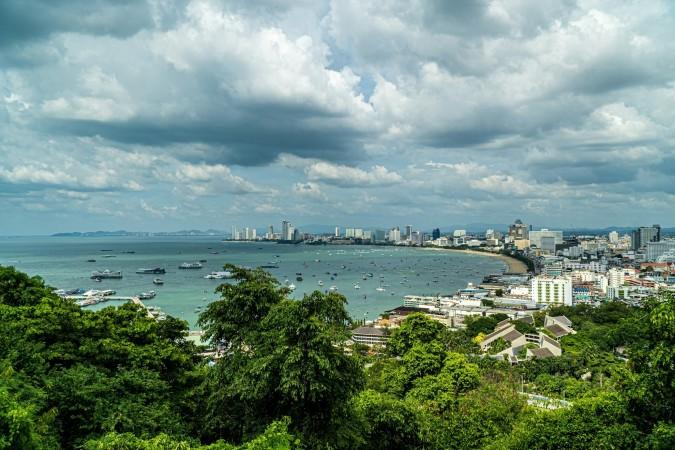
Pattaya city - © Sung Shin
Top Attractions in Pattaya
Pattaya Beach
Pattaya Beach is the city's most famous stretch of sand, offering golden shores and clear, inviting waters. It's perfect for sunbathing, swimming, and a variety of water sports. Whether you're looking to relax under a beach umbrella or dive into the action with jet skis and parasailing, Pattaya Beach has something for everyone.
Jomtien Beach
For a more peaceful beach experience, head to Jomtien Beach. This quieter alternative to Pattaya Beach is ideal for families and those seeking a laid-back atmosphere. Here, you can enjoy a leisurely day of swimming, lounging, or sampling delicious local snacks from beachside vendors.
Wat Phra Khao Yai (Big Buddha Hill)
Wat Phra Khao Yai, also known as Big Buddha Hill, is home to a towering golden Buddha statue that watches over Pattaya. This sacred site offers not only spiritual significance but also panoramic views of the city and coastline. It’s a peaceful spot to reflect and take in the beauty of Pattaya from above.
Pattaya Floating Market
The Pattaya Floating Market offers a unique shopping experience where you can explore traditional Thai goods from the comfort of a boat. Vendors sell everything from handicrafts to street food, providing a taste of Thailand’s rich culture and cuisine in a picturesque setting.
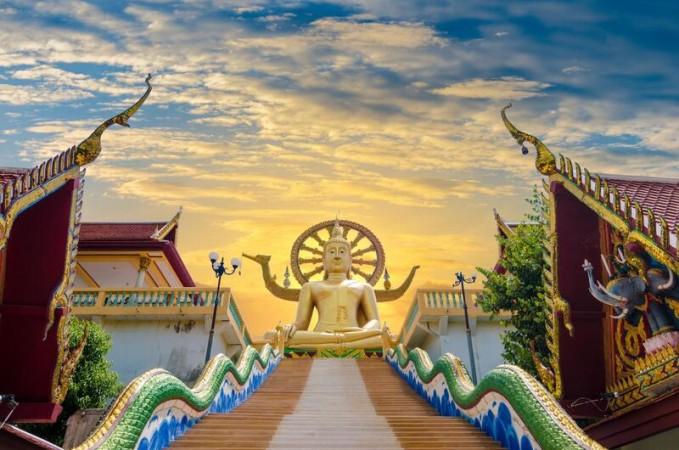
Wat Phra Khao Yai (Big Buddha Hill) - © MIA
Must-Try Dishes in Pattaya
Pattaya is a culinary haven where you can savor a wide range of Thai cuisine and international flavors, reflecting its diverse culture, offering everything from street food delights to fine dining experiences.
- Som Tum (Papaya Salad): Som Tum is a classic Thai dish that perfectly balances sweet, sour, salty, and spicy flavors. Made from shredded green papaya, tomatoes, peanuts, and chili, this refreshing salad is a must-try for anyone seeking an authentic taste of Thailand.
- Tom Yum Goong (Spicy Shrimp Soup): Tom Yum Goong is a fragrant and spicy soup that's famous worldwide. Featuring fresh shrimp, lemongrass, kaffir lime leaves, and galangal, this dish delivers a burst of flavors that exemplify Thai cuisine’s complexity.
- Pad Thai: Pad Thai is a staple of Thai street food, consisting of stir-fried rice noodles with eggs, tofu, shrimp, and bean sprouts, all tossed in a tangy tamarind sauce. It’s often garnished with peanuts and lime, making it a favorite for locals and tourists alike.
- Moo Ping (Grilled Pork Skewers): Moo Ping is a popular street food in Pattaya, offering tender, marinated pork grilled to perfection. Served with sticky rice and a spicy dipping sauce, it’s an irresistible snack that captures the essence of Thai street cuisine.
- Gaeng Keow Wan (Green Curry): Gaeng Keow Wan, or Green Curry, is a rich and creamy dish made with green curry paste, coconut milk, and a choice of meat or vegetables. Its mild sweetness and fragrant herbs make it a comforting dish that’s perfect for those who enjoy savory and aromatic flavors.
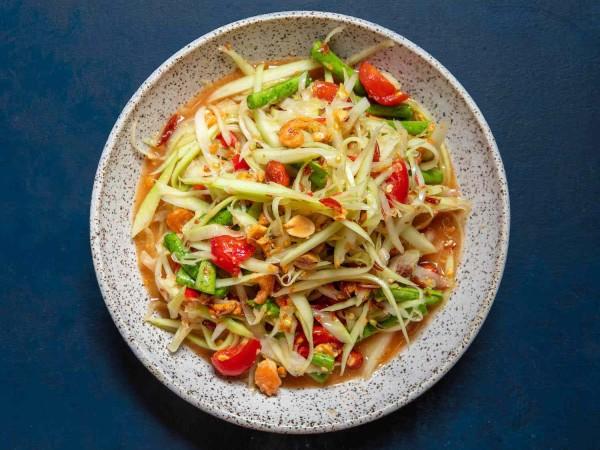
Som Tum (Thai Papaya Salad) - © Serious Eats
Festivals & Local Celebrations
Pattaya hosts a variety of festivals and local celebrations throughout the year, offering visitors a chance to experience the city’s vibrant culture and traditions.
Songkran Festival (Thai New Year)
Songkran, the Thai New Year, is celebrated with great enthusiasm in Pattaya. This water festival takes place in mid-April and involves lively street parties, water fights, and traditional ceremonies. It’s a joyous time when locals and tourists come together to celebrate with splashes of water, symbolizing purification and the washing away of bad luck.
Loy Krathong
Loy Krathong, held in November, is one of Thailand’s most beautiful festivals. In Pattaya, locals and visitors gather by the water to release krathongs (decorative floats) into the sea or rivers. The sight of thousands of glowing krathongs drifting under the moonlight is a magical experience that symbolizes letting go of past grievances and making wishes for the future.
Pattaya Music Festival
The Pattaya Music Festival is an annual event that draws music lovers from all over the world. Held on Pattaya Beach, this free festival features performances by local and international artists across various genres. The festival’s vibrant atmosphere, combined with the beachside setting, makes it a must-attend event for music enthusiasts.
Pattaya International Fireworks Festival
The Pattaya International Fireworks Festival is a spectacular event where the night sky is illuminated with dazzling displays of fireworks. Held annually in November, this festival features performances, parades, and, of course, stunning fireworks shows by teams from different countries. It’s a visual feast that adds an extra sparkle to Pattaya’s lively atmosphere.
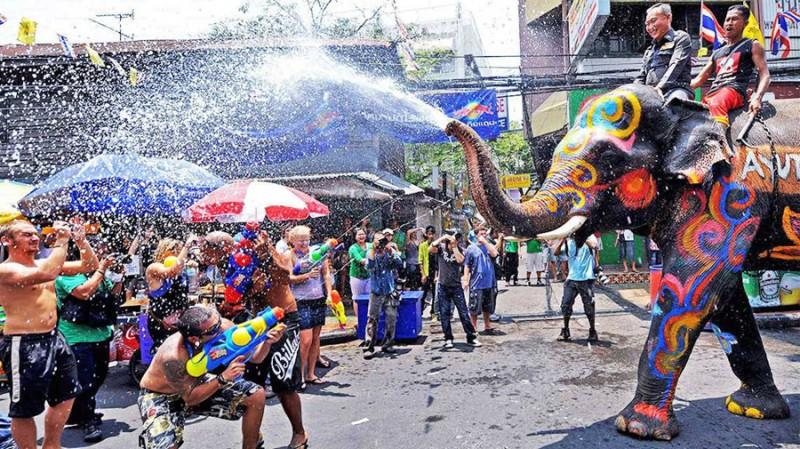
Songkran Festival (Thai New Year) - © Vietnam Plus
What to Do in Pattaya
Pattaya has a diverse range of activities for all types of travelers, whether you want adventure, leisure, or cultural encounters.
- Water Sports and Beach Activities: Activities like jet skiing, parasailing, and snorkeling are popular on Pattaya Beach and Jomtien Beach. For a more tranquil experience, consider renting a kayak or paddleboard to explore the coastline at your own pace.
- Island Hopping: Just a short boat ride from Pattaya, you’ll find beautiful islands like Koh Larn, Koh Sak, and Koh Phai. These islands offer pristine beaches, clear waters, and excellent spots for snorkeling and diving.
- Experience Pattaya’s Nightlife: Pattaya is famous for its vibrant nightlife. Beyond the lively bars and clubs on Walking Street, you can enjoy beachside bars, rooftop lounges, and live music venues throughout the city. For a unique experience, catch a cabaret show at Tiffany’s or Alcazar, where you’ll be treated to extravagant performances by talented drag artists.
- Cultural Tours in Pattaya: For those interested in Thai culture, Pattaya offers several cultural tours that include visits to temples, markets, and traditional Thai villages.
Shopping in Pattaya
Pattaya is a shopper’s paradise, offering everything from luxury malls to bustling street markets, from high-end fashion to unusual souvenirs and local handicrafts.
- Central Pattaya: Central Festival is one of the largest and most popular shopping malls in Pattaya. Located on Beach Road, it offers a wide range of international brands, dining options, and entertainment facilities.
- Pattaya Night Bazaar: For a more local shopping experience, visit the Pattaya Night Bazaar with stalls selling clothing, accessories, and souvenirs at bargain prices. It’s an excellent spot to pick up gifts and practice your bargaining skills.
- Pattaya Floating Market: The Pattaya Floating Market is not just a tourist attraction but also a unique shopping experience. Here, vendors sell traditional Thai products, handicrafts, and delicious street food from boats. It’s a great place to immerse yourself in Thai culture while shopping for one-of-a-kind items.
- Thepprasit Night Market: Thepprasit Night Market is one of Pattaya’s most famous weekend markets. It offers a wide variety of goods, including clothing, electronics, and local foods.
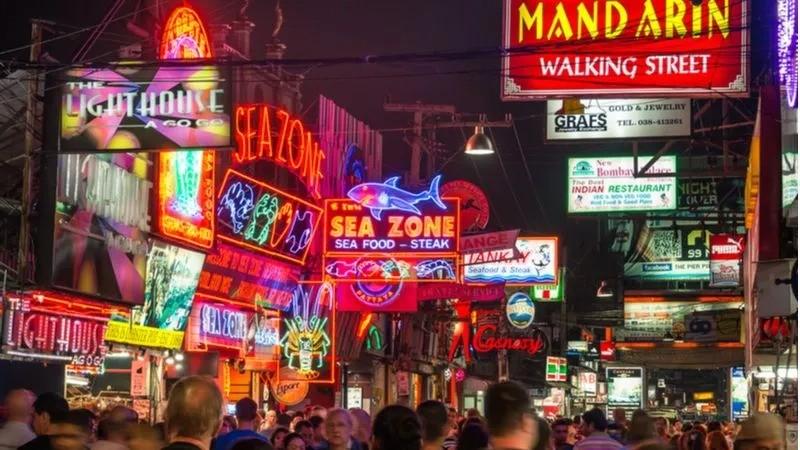
Pattaya Night Bazaar - © Thailand Tourism
Weather in Pattaya: Best Time to Visit
Pattaya enjoys a tropical climate, making it a year-round destination for travelers. However, understanding the seasonal weather patterns can help you plan the perfect trip.
Cool Season in Pattaya
The chilly season is the busiest traveling time to visit Pattaya. With average temperatures ranging from 20°C to 30°C (68°F to 86°F), the weather is pleasant and ideal for outdoor activities and beach relaxation. This period also corresponds with the Christmas season, so expect bigger crowds and higher lodging costs.
Hot Season in Pattaya
The hot season in Pattaya sees temperatures rising to 35°C (95°F) or higher. While the heat can be intense, it's also the perfect time for water sports and enjoying the beach. The crowds are thinner compared to the cool season, making it a good time for those who prefer a more laid-back atmosphere.
Rainy Season in Pattaya
Pattaya’s rainy season brings frequent showers, but they are usually short and intense, often followed by clear skies with temperatures at this time range from 25°C and 32°C (77°F to 90°F). Despite the rain, this season offers a more tranquil experience with fewer tourists, and you can find many great deals on accommodations.
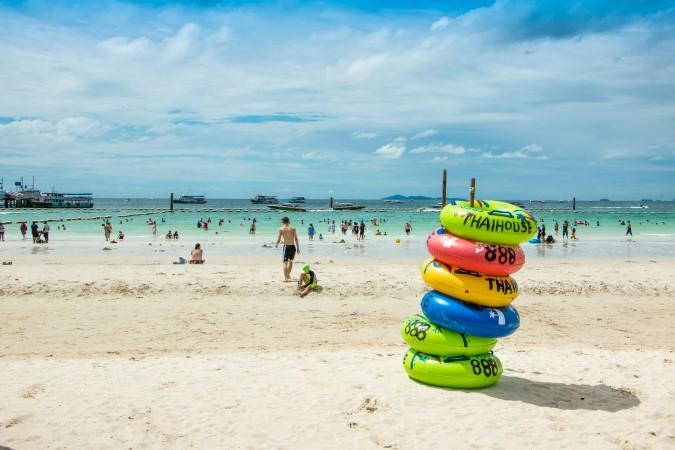
Travel to Pattaya to enjoy the beauty of Pattaya Beach - © Ashwani Verma
Cultural Etiquette in Pattaya
Understanding local customs and etiquette can enhance your experience in Pattaya and show respect to the local community.
- Respect for the Monarchy: Thais hold their monarchy in high regard. It’s important to show respect for the royal family in any context, whether in conversation, when viewing portraits of the king, or during the national anthem.
- Temple Customs: When visiting temples, dress modestly, cover your shoulders and knees and take off your shoes before entering. Avoid touching sacred objects or pointing your feet towards statues of Buddha.
- Greetings and Politeness: The traditional Thai welcome, known as the "wai," is bringing your hands together in a prayer-like gesture and bending slightly. It’s a sign of respect and is commonly used when meeting someone or thanking them.
Essential Travel Information
Getting Around Pattaya
- Songthaews (Baht Buses): Songthaews are the most popular mode of transport in Pattaya. These shared, open-air trucks follow fixed routes around the city and are an affordable way to get around.
- Motorbike Taxis: Motorbike taxis are another common way to navigate Pattaya, especially for short distances. They are fast and can weave through traffic easily, but always remember to negotiate the fare before starting your ride.
- Taxis and Ride-Hailing Services: Metered taxis are available in Pattaya, though for more convenience, you can use ride-hailing apps like Grab, which offers transparent pricing and the ease of booking through your smartphone.
- Renting Motorbikes or Cars: For those who prefer more independence, renting a motorbike or car is a great option. Make sure to have an international driving permit and always drive cautiously, as traffic can be unpredictable.
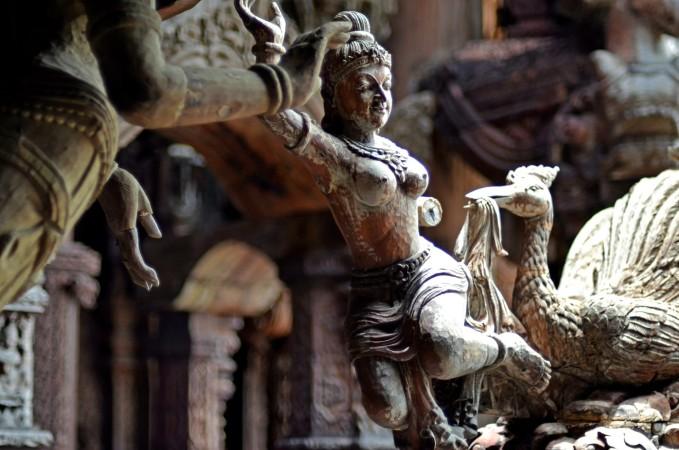
Admire the beauty but do not touch the sacred statues when visiting Pattaya's temples - © Tatiana Tochilova
ATM & Banking Services
Managing your finances in Pattaya is straightforward, with a variety of ATM and banking services available throughout the city. ATMs are commonly found in major shopping centers, convenience stores, and along busy streets. Currency exchange booths are plentiful in tourist areas and generally offer competitive rates, though it’s wise to compare a few options. Additionally, credit cards are widely accepted in hotels, restaurants, and larger stores, but it’s advisable to carry some cash for smaller transactions or when visiting more remote areas.
Where to Stay in Pattaya
- Luxury Hotels and Resorts: For those seeking a high-end experience, Pattaya boasts several luxury hotels and resorts. These properties offer world-class amenities, stunning sea views, and impeccable service. They typically feature multiple dining options, spa facilities, and private beach access.
- Mid-Range Hotels: Mid-range hotels are plentiful in Pattaya, providing comfortable rooms and good service at affordable prices. These hotels offer a balance of comfort, convenience, and value for money, often including amenities such as swimming pools, fitness centers, and on-site restaurants.
- Beachfront Villas: Renting a beachfront villa offers a private and elegant experience. These villas offer direct access to the beach, private pools, and customized services. They are ideal for travelers seeking privacy and exclusivity while enjoying Pattaya’s stunning coastline.
Articles for you

Explore Yala National Park - Sri Lanka Travel, Asia
Tucked away in Sri Lanka’s southeastern corner, Yala National Park is where wild nature meets deep tradition. Known worldwide for its leopard population, the park is also home to elephants, sloth bears, crocodiles, and hundreds of bird species. Beyond wildlife, Yala opens doors to a cultural landscape dotted with ancient temples, Buddhist ruins, and coastal villages. For travelers seeking more than just a safari, Yala offers a chance to explore eco-tourism, local communities, and sacred heritage sites.
Population: The Yala National Park area doesn’t have a human population.
Economy: The economy around Yala National Park thrives on a blend of eco-tourism, agriculture, and local services. Safari tours, eco-lodges, and cultural experiences drive steady income for nearby towns like Tissamaharama and Kataragama, supporting thousands of families.
Landmarks: Famous for Block I of Yala and wildlife encounters, including elephants, sloth bears, crocodiles, and exotic bird species.

Explore Galle - Sri Lanka Travel, Asia
Nestled on Sri Lanka’s southern coastline, Galle is a vibrant city where history meets the sea. Its cobbled streets, colonial architecture, and serene beaches make it a must-visit destination for travelers seeking a blend of culture, adventure, and relaxation. A UNESCO World Heritage site, Galle captivates visitors with its Dutch Fort, bustling markets, and friendly locals. Whether you’re exploring the ramparts at sunset or savoring fresh seafood by the shore, Galle promises an unforgettable journey into Sri Lanka’s heritage.
Population: Approximately 113,000 in 2023.
Economy: Galle’s economy thrives on tourism, trade, and fisheries. The city’s historic fort, colonial architecture, and coastal charm draw thousands of international visitors each year, making tourism its main economic driver. Fishing remains vital for local livelihoods, supplying fresh seafood across the region.
Landmarks: Famous for the Galle Fort, Dutch Reformed Church & Maritime Museum, and Unawatuna Beach.

Explore Bentota - Sri Lanka Travel, Asia
Nestled along Sri Lanka’s southwestern coast, Bentota is a tropical paradise that blends golden beaches, vibrant culture, and thrilling adventures. Famous for its calm waters, luxury resorts, and scenic river estuary, Bentota has become a top destination for travelers seeking both relaxation and authentic experiences. From serene beach walks at sunrise to adrenaline-pumping water sports, this coastal town offers a perfect balance of leisure and exploration. With its proximity to Colombo and Galle, Bentota is easy to reach, making it an ideal stop for both short escapes and extended holidays.
Population: Approximately 37,000 in 2023.
Economy: Bentota’s economy thrives mainly on tourism, which drives local businesses such as hotels, restaurants, and wellness retreats. The town also benefits from fishing, coconut cultivation, and handicrafts like wood carving and batik textiles. Many residents rely on the growing demand for water sports and Ayurvedic treatments, making tourism the backbone of both income and employment in the area.
Landmarks: Famous for Bentota Beach, Bentota River Safari, and Kande Vihara Temple.

Explore Mirissa - Sri Lanka Travel, Asia
Mirissa is a charming coastal town on Sri Lanka’s southern shoreline. Known for its golden beaches, turquoise waters, and vibrant marine life, it has become a must-visit stop for travelers exploring the island. Many come for whale watching, surfing, and sunset views at Coconut Tree Hill, but Mirissa offers much more than postcard beauty. The fishing boats you see anchored by the bay carry generations of stories. Local traditions, delicious cuisine, and a laid-back rhythm of life shape every visitor’s experience.
Population: Approximately 4,700 in 2023.
Economy: Mirissa’s economy is largely shaped by its coastal location. Fishing has long been the backbone of local livelihoods, with generations relying on the Indian Ocean for income. In recent decades, tourism has become the main driver of growth, thanks to whale watching, surfing, and beachside hospitality.
Landmarks: Famous for Mirissa Beach, Coconut Tree Hill, and Parrot Rock Bridge.

Explore Nuwara Eliya - Sri Lanka Travel, Asia
Tucked away in the Central Highlands of Sri Lanka, Nuwara Eliya is often called “Little England”. With its rolling tea plantations, cool misty mornings, and colonial charm, this mountain town feels like a step into another world. Travelers come here to breathe fresh air, walk through flower gardens, sip the finest Ceylon Tea, and enjoy a pace of life far from the island’s busy cities. Whether you’re drawn by scenic landscapes, heritage architecture, or the warmth of its people, Nuwara Eliya is a destination that blends nature, culture, and history in perfect harmony.
Population: Approximately 781,000 in 2023.
Economy: Nuwara Eliya’s economy thrives mainly on tea production, as it sits in the heart of Sri Lanka’s central highlands, famous worldwide for Ceylon Tea. The city also benefits from a growing tourism industry, attracting visitors with its colonial charm, cool climate, and scenic landscapes.
Landmarks: Famous for Gregory Lake, Hakgala Botanical Garden, and Victoria Park.

Explore Sukau - Malaysia Travel, Asia
Nestled on the banks of the Kinabatangan River in Sabah, Malaysian Borneo, Sukau is a destination where wildlife, culture, and conservation come together. Known as one of Asia’s top spots for river safaris and eco-tourism, this quiet village offers a front-row seat to encounters with Bornean orangutans, pygmy elephants, proboscis monkeys, and exotic birdlife.
Population: Approximately 1,400 in 2019.
Economy: Sukau’s economy is shaped by its riverine location and natural resources. Traditionally, the Orang Sungai community relied on fishing, small-scale farming, and forest gathering for their livelihood. Today, the village has shifted toward eco-tourism, with river cruises, jungle trekking, and homestays providing income.
Landmarks: Famous for the Kinabatangan River cruises, Gomantong Caves, and Ox-bow lakes and wetlands.
